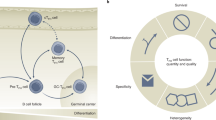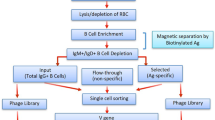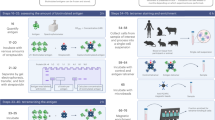Abstract
THE hapten-carrier effect in immune responses demonstrates that one antigenic determinant can strongly modulate the antibody response to a second determinant if the two exist in physical association. This phenomenon, in more general form termed associative recognition1, has been analysed with soluble antigens and reveals collaboration between carrier-directed, helper T cells and hapten-directed, antibody-producing B cells. In contrast to soluble antigens, antibody responses to surface antigens of nucleated cells are poorly understood and although collaboration among T and B cells is indicated in several studies2–4 the antigenic sites recognised by these T cells and the extent of associative recognition among the different antigenic determinants on cell membranes is not known. Thus, it is not clear whether the determinants recognised by T and B cells are controlled by a single gene and are joined covalently or if the two determinants are controlled by independent genes and are only loosely associated or even unassociated on the cell surface. This knowledge would help determine the character and extent of molecular interactions on the surface of nucleated cells as well as principles of immunogenicity of antigens expressed on cell membranes. This report extends previous findings1,5 and describes a new experimental approach to study, in primary responses the role of alloantigens in the immunogenicity of Thy-1 through the use of closely related donor-recipient strains and an assay for antibody plaque-forming cells (PFC). The results are consistent with the notion that in primary immune responses Thy-1 is ‘helpless’ but that in appropriate donor strains, help may be supplied by other alloantigens controlled elsewhere in the donor genome.
This is a preview of subscription content, access via your institution
Access options
Subscribe to this journal
Receive 51 print issues and online access
$199.00 per year
only $3.90 per issue
Buy this article
- Purchase on SpringerLink
- Instant access to full article PDF
Prices may be subject to local taxes which are calculated during checkout
Similar content being viewed by others
References
Lake, P. & Mitchison, N. A. Cold Spring Harb. Symp. quant. Biol. 41 (1977).
Miller, C. L. & DeWitt, C. W. Cell. Immun. 13, 278–287 (1974).
Klein, J., Livnat, S., Hauptfeld, V., Jerabek, L. & Weissman, I. Eur. J. Immun. 4, 41–44 (1974).
Kindred, B. & Corley, R. B. Nature 268, 531–532 (1977).
Lake, P. & Mitchison, N. A. in Immunology of Receptors (ed Cinader, B.) 407–417 (Marcel Dekker, New York, 1977).
Schlesinger, M. & Hurvitz, D. Transplantation 7, 132–141 (1969).
Acton, B. T. et al. Nature new Biol. 245, 8–10 (1973).
Lake, P. Nature 262, 297–298 (1976).
Mitchison, N. A. Eur. J. Immun. 1, 18–27 (1971).
Schendel, D. J. & Bach, F. H. J. exp. med. 140, 1534–1547 (1974).
Vitetta, E. S., Poulik, M. D., Klein, J. & Uhr, J. W. J. exp. Med. 144, 179–192 (1976).
Sanderson, A. R. Nature 269, 414–417 (1977).
Shen, F. W., Boyse, E. A. & Cantor, H. Immunogenetics 2, 591–595 (1975).
Wernet, D. & Lilly, F. J. exp. Med. 141, 573–579 (1975).
Mitchison, N. A. & Lake, P. in Regulatory Mechanisms of the Immune System: ICN–UCL Symposia on Molecular and Cellular Biology VI, 555–558 (Academic, New York, 1977).
Author information
Authors and Affiliations
Rights and permissions
About this article
Cite this article
LAKE, P., DOUGLAS, T. Recognition and genetic control of helper determinants for cell surface antigen Thy–1. Nature 275, 220–222 (1978). https://doi.org/10.1038/275220a0
Received:
Accepted:
Issue date:
DOI: https://doi.org/10.1038/275220a0
This article is cited by
-
Characterization of variant and parental-cross-protective immunity to immunogenic variants of a murine fibrosarcoma using the local adoptive transfer assay
Cancer Immunology Immunotherapy (1989)
-
The Ir-Thy-1 concept: A swan song
Immunologic Research (1989)
-
The Ir-Thy-1 concept: Continuing saga
Immunologic Research (1986)
-
IA mutation affects anti-Thy-1 response in mice
Immunogenetics (1985)
-
Evaluation of in vivo and in vitro effectivity of immune defense against a spontaneously arising, nonlymphoid rat tumor
Cancer Immunology, Immunotherapy (1985)



